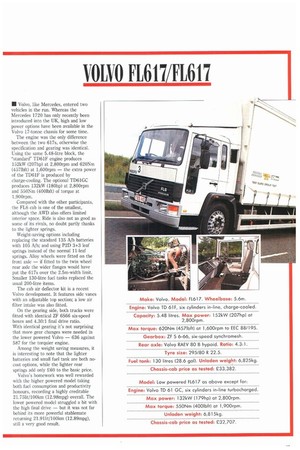VOLVO FL617/FL617
Page 39

If you've noticed an error in this article please click here to report it so we can fix it.
• Volvo, like Mercedes, entered two vehicles in the run. Whereas the Mercedes 1720 has only recently been introduced into the UK, high and low power options have been available in the Volvo 17-tonne chassis for some time.
The engine was the only difference between the two 617s, otherwise the specification and gearing was identical. Using the same 5.48-litre block, the "standard" TD611+ engine produces 152kW (207hp) at 2,800rpm and 620Nm (4571bft) at 1,600rpm — the extra power of the TD61F is produced by charge-cooling. The optional TD61GC produces 132kW (180hp) at 2,800rpm and 550Nm (4001bft) of torque at 1,90Orpm.
Compared with the other participants, the FL6 cab is one of the smallest, although the AWD also offers limited interior space. Ride is also not as good as some of its rivals, no doubt partly thanks to the lighter springs.
Weight-saving options including replacing the standard 135 Afh batteries with 105 Afh; and using P2D 3+3 leaf springs instead of the normal 11-leaf springs. Alloy wheels were fitted on the front axle — if fitted to the twin wheel rear axle the wider flanges would have put the 617s over the 2.5m-width limit. Smaller 130-litre fuel tanks replaced the usual 200-litre items.
The cab air deflector kit is a recent Volvo development. It features side vanes with an adjustable top section; a low air filter intake was also fitted.
On the gearing side, both trucks were fitted with identical ZF 6S66 six-speed boxes and 4.30:1 final drive ratio. With identical gearing it's not surprising that more gear changes were needed in the lower powered Volvo — 636 against 587 for the torquier engine.
Among the weight saving measures, it is interesting to note that the lighter batteries and small fuel tank are both nocost options, while the lighter rear springs add only £60 to the basic price.
Volvo's homework was well rewarded with the higher powered model taking both fuel consumption and productivity honours, recording a highly creditable 21.751it/100km (12.98mpg) overall. The lower powered model struggled a bit with the high final drive — but it was not far behind its more powerful stablemate returning 21.91lit/100km (12.89mpg), still a very good result.












































































